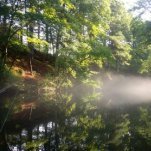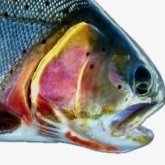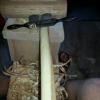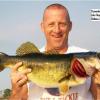-
Content Count
2,402 -
Joined
-
Last visited
Community Reputation
0 NeutralAbout Capt Bob LeMay
-
Rank
Advanced Member
Previous Fields
-
Favorite Species
Everything that swims in the 'Glades
-
Security
22
Contact Methods
-
Website URL
http://
-
ICQ
0
Profile Information
-
Location
south Florida
Recent Profile Visitors
20,548 profile views
-
Here's a step by step one of the ways I do "clousers" (most I know consider that to be a tying style as opposed to a specific pattern...). This particular version, on a 2/0 Mustad 34007 hook, is a standard for working shorelines in the backcountry of the Everglades - we also use it in freshwater when the fish are larger and aggressive -but in brighter colors (see April patterns) and in different sizes... but at one time or another we use "clousers" as small as size #2 and as large as 3/0 depending on what forage is present... This fly is almost foul-proof and the wire weedguard allows an angler to toss his bug into the bushes and actually slide it back out without snagging up (very handy in my area... this version was named for Whitewater Bay where it gets a lot of use...). Note.... the wire size is dependent on hook size - for hooks 1/0 and larger -#5 wire, for hooks #2 and #1 we use #4 wire... Hook: Mustad 34007 2/0 Eyes: large beadchain (the same size as the pull cord on vertical blinds.... Thread : Danville's flat waxed (or equivalent in 210 denier...), fl Fire orange, fl. green Body: double course of orange tying thread (also used to secure eyes..) Wing: white bucktail twice the hook's length, with fl. green bucktail over (after adding flash...) Flash: pearl Flashabou between white and green wing... Weedguard: Malin's trolling wire, coffee colored #5 Finish: none, after tying and before wire is bent into position, thin superglue on head (Krazy Glue) Start thread one beadchain width behind hook eye, do a double course to hookpoint then back, figure eight eyes into position... tie off.. this pic shows the weedguards ready to use - they'll be tied in by the hairpin end and remain sticking out as the fly is completed (you might need a band-aid or two learning to use them....) Reverse hook to ride point up, change thread to fl. green then tie in weedguard by the bend pointing straight forward as shown. Learning to complete the pattern with that wire sticking out... might require a couple of band-aids until you get the hang of it.. first part of the wing tied in place, then 6 strands of pearl flashabou is wound around the barrel of your bobbin and slid into place on top of the white bucktail (strands have staggered ends..). the fiinal fl. green bucktail is tied in on top of the white, then the head is completed, whip finished and tied off. Now raise the wire a bit (to get it away from the hook eye - then coat the head lightly with thin super glue.. Once the super glue dries bend weedguard into place then trim it at the hook's barb and do a small final bend and you're done.
-
One of my anglers asked about the patterns we're using for peacock bass locally - here's a sampling ranging from as small as a #2 - all the way up to a 2/0 for the "clousers".. The small maribou fly is a Crystal Schminnow in size #4... most in my area consider that a clouser is more of a tying style than a specific pattern... I have a tying sequence that I'll post separately...
-
I was one of those vets who came home in 1971 - when we snuck back into the country and did everything possible to avoid wearing the uniform... The current fashion of thanking young folks for their service is a far cry from that era. Not a bad thing at all - but it's not what we experienced at all. I suspect that most of us simply got on with our lives, keeping a low profile. To this day I don't belong to any veteran's groups although I was an Army brat and grew up all over the world before I went in the service myself in 1968. My Dad was a career type and did two tours in Vietnam in '65 and '69 before retiring in 1970...
-
Our night trips... are never in jungle areas at all (after a lot of years you learn where not to fish..). Instead we're fishing the urban areas (between Miami and Miami Beach in Biscayne bay - or up at Jupiter...) where we're pretty much bug free. All of our night stuff revolves around docklights or in the shadows up under a bridge somewhere. The night scene for us is all about sight-fishing and we're looking at every fish we encounter, mostly... You have to stand off of docklights but in bridge shadows we're working so close to small (20 to 40lb tarpon mostly) that you can almost reach out and touch one with your rod... It was the very first thing I was introduced to - in 1972.... and I'd been doing the night scene for a lot of years before I took up guiding.
-
Love that brutal winter weather ... it causes my phone to ring down here in paradise where we get all covered up when the weather is below 70 degrees... On the other end of the scale - when summer comes around I don't get too many bookings to fish the 'glades at all... even though the fishing gets better and better all summer long (while the actual jungle conditions get worse and worse...). Thank heavens for night trips.
-
Not sure if I've mentioned this before... several of my wholesalers have mentioned that covid really messed up some of their local supply sources for things like bucktails, squirrel tails, etc. and that they've been having great difficulty obtaining commercial quantities of natural furs/ tails... Hope this is just a temporary situation. I'd advise anyone to buy those kinds of materials at your local shop these days (if possible) so that you can get a hands on evaluation of exactly what you're buying... Wish it weren't so...
-
This time of year everything's biting in the 'glades... This snook was caught and released with an 8wt rod and new streamer we've been using.... That fly took at least 20 fish that day.... Tail: old yellowed polar bear Hook: Owner Aki light in size #1 Body: synthetic Body Fur in fl. yellow Eyes: Wapsi presentation lead eyes Weedguard: #4 trolling wire (Malin's stainless, coffee colored. Note... during my years filling fly orders for shops and anyone else who knew what they wanted.. I never used any of my small supply of polar bear for a single fly... Years later, as the hair is almost no longer usable I'm beginning to use a bit of it here or there...
-
Most of the time I'm a wholesale operator and doing my orders by phone... When there's something on my shopping list that's a critical item (needed to fill an order I'm working on, or needed for my guiding work) I've learned to request a call back after they've pulled the order to find out then if what I need is out of stock, so I can look elsewhere instead of waiting to find out when I receive my goods a few days later (or a week or two later in a few cases... If I have the slightest doubt that they'll call me back I'll make a point of getting the individual's contact info while placing my order and do a call back myself... before the end of their working day to verify that what I'm needing is (or isn't) in that order when it's shipped... This routine, of course, was learned the hard way.... Over the years I've learned that an occasional supplier was not reliable in one way or another - that business was off of my list to purchase from the moment they let me down... Matter of fact I've just found my very first defective fly line in nearly fifty years of fly fishing - after only two days usage and will be contacting the manufacturer directly later on today. Their response will tell me whether I'll be using their lines in the future. I try to keep at least one spare new line for every line size from a 5wt up to a 12wt on hand (in some cases, 8, 9 and 10wt lines - two spares...). The backcountry of the Everglades, all mangrove jungle shorelines... is very hard on fly lines and my floating lines rarely last more than one year for my anglers... Note... Very pleased, that line manufacturer stepped up, requested I send in the line so they could examine it - and will send a replacement.. .They'll be getting more orders from this corner...
-
We're nearly over-run with juvenile goliath grouper in the backcountry (interior) of the Everglades and nearby areas these days. By juveniles - I mean fish less than fifty pounds. They've been fully protected now for nearly thirty years and as a direct result they've been allowed to increase in population to the point that they're displacing other species... Here's my latest example - a seven pound specimen taken in less than two feet of water while trying to catch a redfish or snook instead... a great catch on an 8wt rod using a Seaducer pattern - but in a very shallow interior shoreline where you'd never expect to see one at all.. Kind of a mixed blessing I guess - but one more example of why my state needs to re-consider its protected status... tougher than an old leather boot and quite aggressive - they're the baddest fish in the 'glades - now if there were just not so many of them... Of course, like always - this specimen was carefully caught and released...
-
Last night the tarpon took my anglers to school... We jumped a half dozen or more in bridge shadows and docklights using both lures and flies. The fish, a mix of small tarpon in the 20 to 50lb range were up at the surface and feeding - perfect sight-fishing conditions. My father and son anglers (Dad with the fly rod, 15 year old son with light spinning gear) got introduced to the night scene in the usual way - breaking off fish on the strike or hanging on as the fish jumped off after the hook up... Great fun between Miami and Miami Beach... Here's a pic of the flies we used in sized 1/0 and 2/0.... Always in white so my anglers can see where the fly is in relation to the fish at night... The rods I have for night trips are an 8,9, and 10wt (the ten weight is reserved for nights when the bigger fish are in the shadows...). This time of year it's all happening - the backcountry of Everglades National Park for day trips (Flamingo, Chokoloskee, or Goodland to the north, near Marco Island), night trips in Biscayne Bay or up in Jupiter, and peacock bass with other exotics in local canals...
-

(No fly zone) Non fly caught fish pictures
Capt Bob LeMay replied to caloosa bug's topic in The Lodge
This time of year we're going day after day (nice to have anglers... but be careful what you wish for...) - freshwater, saltwater, day trips, night trips.... when that great flood of visitors heads our way.. By May things begin to slow down (as customers begin to dwindle - the fishing, though, gets better and better...) and in summer - not many want to fish in the jungle with me... In the meantime I come up for air a day here or there... with lots to do - then it's back on the water... Here's a pic from last week of a nice redfish out of Flamingo in Whitewater Bay where the reds have that great mahogany red/brown copper color... carefully released after an encounter with a small leadhead on light spinning gear... Today I'll be sourcing a new stern light for my skiff... Trying to stuff a seven foot wide skiff up a six foot wide creek - has consequences... -
Water temps in the 'glades are a bit higher than normal for this time of year... We had 81 degree waters in the afternoon... For those who've never fished tarpon - water temperature is what gets them moving - not time of year or any other factor... The interior of the 'glades is simply warmer than waters out in the Gulf - and that's why Flamingo, Chokoloskee, Goodland and the entire Ten Thousand Islands area gets the first crack at the big fish - before the spawning migration gets going each year..
-
Finally our weather warmed up a bit - and stayed that way... In the backcountry of the 'glades our waters warmed up 12 degrees in just a few days - and the giant tarpon responded by flooding up into interior bays out of the cooler Gulf waters they've been holding in... On our first of two days the wind was blowing and we only saw a few of the big fish but weren't able to get on them properly. That day I was fishing local angler Bill Myers and his buddy Andrew... We mixed it up with Bill on the fly rod in the bow and Andrew with light spinning gear at the rear and found snook, speckled trout, and redfish along mangrove jungle shorelines for both anglers, at times double hookups. The snook were small, the redfish nice sized, and the trout were numerous but only a few of them were keeper sized.. Here's a pic of a nice redfish that Andrew caught and released. the reds in our interior areas are all this gorgeous red brown color... That day we kept two nice trout for dinner - an 18 and a 19" - both loaded with roe.... It's that time of year when the trout will flood into our area all of them roe laden and fully mature. When the conditions are right - we do really well using popping bugs on fish holding in feeding lane currents with them. The next day I had Chris Frohlich and his Dad Court on board fly fishing for the big tarpon... Chris was the sole angler that day with his Dad along to watch and do a bit of filming if possible. Chris is a very skilled tarpon angler, able to lay out a full 120 foot tarpon line in the right conditions. We found the big fish early on, laid up in a sheltered area in a big open bay , just occasionally rolling in three to five feet of water (and every now and then floating just under or right at the surface, showing only the very tip of a fin here or there.... I was on the pole most of that day and fish after fish - simply ignored our flies.... typical tarpon (you could hear them snoring....). Finally late in the day the fish perked up, began moving around and actually doing a bit of feeding. Chris began to see fish following the fly although still with lockjaw until one, only thirty feet from the skiff did a perfect eat and it was game on... with a fat eighty pound fish (there were a lot of tarpon in that immediate area - some of them really way over one hundred pounds...). I was only able to take one photo of the action (and I'm hoping to get a small video clip from Court...). That one fish, though really made our day... Hooked up solid with an 11wt rod We like to use much bigger tarpon flies than folks in the Keys favor... This pattern a Tarpon Snake variation, was the tarpon food that day... Just nothing like the Everglades... "Be a hero... take a kid fishing..." Bob LeMay (954) 435-5666






